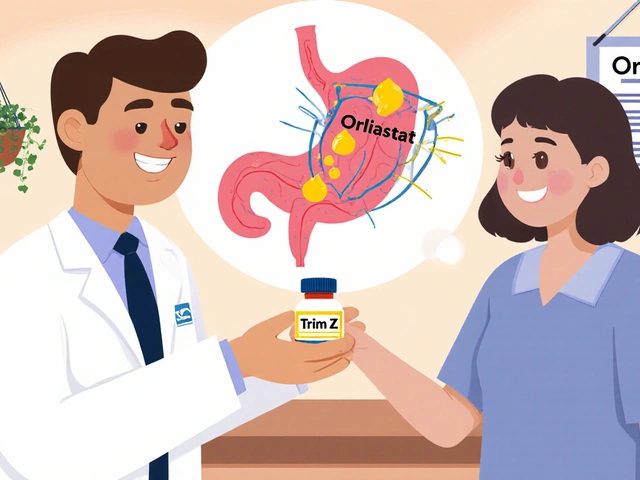
As of 2024, there are numerous alternatives to Vibramycin available for those battling bacterial infections. Understanding these options is crucial for making informed health decisions. Each alternative comes with its unique benefits and potential drawbacks, depending largely on the type of infection being treated and patient-specific factors. This guide aims to shed light on these alternatives, providing concise and practical information to help in choosing the right antibiotic regimen.
Minocin: A Versatile Alternative
Minocin, known generically as minocycline, is a notable second-generation tetracycline antibiotic celebrated for its versatility in treating a variety of infections. This antibiotic is particularly efficient against skin, acne, respiratory, gut, and urinary tract infections. It is also known to be effective in the management of sexually transmitted infections such as chlamydia. In cases where penicillins are not an option, Minocin serves diligently as a second-line antibiotic for syphilis and gonorrhea. Interestingly, despite its traditional anti-bacterial role, Minocin has also found a niche in treating leprosy, showcasing its adaptability across diverse medical needs.
In recent years, the use of Minocin has extended beyond its original spectrum. It is often chosen for its remarkable anti-inflammatory properties, which explains its popularity in the treatment of acne. Acne, a condition that plagues many during their teenage years and sometimes beyond, can be both distressing and challenging to treat. Minocin helps alleviate this by reducing the inflammation associated with acne lesions. This characteristic makes it an attractive option not just for young adolescents, but also for adults grappling with persistent acne.
"Minocin is an indispensable part of acne management," notes Dr. Jenna Klein, a dermatologist renowned for her work on acne treatments.Notwithstanding its myriad uses, it is crucial to recognize and consider the side effects associated with Minocin. Users often report experiencing anorexia and flatulence, which, while not life-threatening, can cause considerable discomfort. Others have reported more disorienting impacts like lightheadedness, dizziness, and vertigo which may interfere with daily activities.
The most unsettling aspect for some might be its effect on coordination, with some experiencing gait changes. For those who require the antibiotic intravenously, adverse reactions at the injection site can sometimes occur. On a more concerning note, long-term use has been linked to more severe effects like enamel hypoplasia, especially when it comes to developing teeth in younger patients. This emphasizes the importance of careful consideration when prescribing Minocin, especially to younger patients or those who might need it for an extended period. Yet, despite these potential drawbacks, for many, the benefits of Minocin when prescribed appropriately far outweigh the risks. It's no surprise why it continues to be a trusted alternative to Vibramycin, especially in scenarios where that extra anti-inflammatory boost is required.
Seysara
Seysara, known scientifically as sarecycline, marks a shift in acne treatment thanks to its targeted approach for tackling moderate to severe acne in individuals aged nine and up. This FDA-approved antibiotic, part of the tetracycline family, operates by honing in on the bacteria responsible for acne, diminishing their presence directly on the skin's surface. Such specificity, fundamentally different from the broader-spectrum antibiotics, heralds a significant evolution in dermatology and patient care. Historically, broad-spectrum antibiotics were employed with notable success, yet this approach often led to complications such as antibiotic resistance. Now, with Seysara, dermatologists are equipped with a more precise weapon in their arsenal, addressing acne without the widespread and sometimes unwelcome effects seen with its predecessors.
The distinction of Seysara lies not just in its targeted action but also in its suitability for younger patients starting from the age of nine, offering a much-needed solution for young individuals grappling with severe acne. Acne significantly impacts self-esteem and can lead to long-lasting scars if not treated effectively. While some tetracyclines inadvertently affect other bacteria, Seysara stays committed to battling just the bacteria on the skin, reducing potential side effects too. The innovation here represents a leap forward—one tailored to ensure that the treated adolescents and adults can enjoy clear skin without the burden of harsh treatments. According to Dr. Joshua Zeichner, a dermatologist at the forefront of acne therapy, "Seysara represents the direction we hope many treatments will take—targeted, efficient, and patient-friendly."
Pros
- Targets acne-causing bacteria specifically, minimizing collateral impact on beneficial bacteria.
- Approved for use in young individuals, enhancing accessibility for patients over the age of nine.
- Reduces potential for antibiotic resistance by focusing only on problematic bacterial populations.
Cons
- Side effects common to other tetracyclines might occur, though usually less pronounced.
- Effectiveness may vary based on the patient's age or underlying health conditions.
Given its innovations, it's no surprise that Seysara becomes a topic of lively discussion at dermatology conferences and among skincare professionals. Its entry into the medical field underscores the need for a continuous update in treatment protocols and a reminder of how rapidly medical science is advancing. As more individuals seek acne treatment, Seysara's role in providing a more targeted approach inspires confidence in therapies to come, prompting ongoing research and refinement in antibiotic development. This innovation aligns both with current medical trends and the personalized needs of patients seeking invisibly powerful, yet visibly gentle solutions to skin concerns.

Sumycin (Tetracycline): A Classic Antibiotic Option
Sumycin, known by its generic name tetracycline, is a first-generation tetracycline antibiotic that has stood the test of time in treating a broad spectrum of bacterial infections. Developed in the mid-20th century, Sumycin works by arresting protein synthesis in bacteria, effectively causing them to perish or cease multiplying. It's a drug revered in medical communities for its versatility against various infections, from respiratory tract issues to skin conditions and more.
A standout feature of Sumycin is the significant breadth of bacterial strains it targets. This capability makes it particularly beneficial in conditions where the specific bacterial cause might not be immediately identified. For example, it’s frequently used as a first-line treatment for acne, helping thousands to manage severe outbreaks by reducing the troublesome bacteria on the skin. Moreover, its application extends to treating pneumonia, certain respiratory issues, and more uncommon conditions like certain types of urinary tract infections.
Pros and Cons of Sumycin
For all its strengths, like any medication, Sumycin has its pros and cons. The antibiotic's wide reach means that medical professionals often trust it in situations where quick action is needed to tackle bacterial spread. In addition, its long-standing use offers a history of effectiveness that clinicians can rely upon. However, Sumycin might not be as potent as some newer antibiotics, especially in cases isolated to specific or resistant bacterial strains.
Catherine Allen, a leading expert in infectious diseases, emphasizes that “while newer antibiotics are emerging, classics like Sumycin remain invaluable in our therapeutic arsenal, especially when tailored solutions are necessary.”
On the downside, there are notable risks associated with Sumycin. It’s generally contraindicated for children under the age of eight, as it can lead to tooth discoloration, a side effect that calls for caution when prescribing. Furthermore, because it can disrupt the balance of normal gut flora, it can sometimes lead to adverse digestive symptoms, which are important to monitor alongside treatment. These factors are critical considerations in prescribing Sumycin, balancing risks against therapeutic benefits.
Historically, the medical use of Sumycin paints a vivid picture of antibiotic evolution. It remains a cornerstone in combating infections that do not respond to more specialized or modern drugs, emphasizing its role in the broader landscape of antibiotic treatments. As with any longstanding medication, safe use necessitates awareness of both its strengths and its limitations, making patient education and informed healthcare provider decisions vital.
Tygacil
Tygacil, known generically as tigecycline, is a broad-spectrum antibiotic that's often reserved for tough cases where other antibiotics might falter. Approved after rigorous testing, it's made quite an impact since its introduction. It's hailed for its ability to battle a variety of difficult bacterial infections, particularly those involving resistant strains. This quality makes it a potent choice particularly for infections that simply will not respond to more common antibiotics. Its efficacy covers skin infections, soft tissue infections, and certain intra-abdominal infections, making it a tool of choice in the arsenal against serious bacterial invaders.
One of the most forward-thinking things about Tygacil is its ability to counteract resistant bacteria—truly a marvel considering the rising specter of antibiotic resistance in our world today. In fact, resistance is at such a level that even the World Health Organization labels it a pressing public health challenge. This is where Tygacil's broad-spectrum abilities shine, bridging gaps where other treatments fall short. However, as a strong medication, it comes with its own set of possible side effects, which can sometimes include nausea and vomiting—relatively mild, yet important to monitor.
Citing a Health Expert, Dr. Peterson remarked, "Tygacil has become indispensable in clinical settings, offering solutions where others fail. It's critical in holding back the tide of resistant infections."
When considering Tygacil as a treatment option, physicians typically weigh its robust benefits against potential downsides. Since its introduction, the safety profile of Tygacil has been closely monitored, and while uncommon, some side effects pop up more often in those with severe infections being treated for extended periods. This is due, in part, to its strong pharmacological nature, honed to target stubborn bacteria while minimizing harmful impacts. For the healthcare community and patients alike, it's an intricate balance between the risk and reward.
It's worth noting that Tygacil is generally preserved for more serious infections, with healthcare providers thoughtfully prescribing it to ensure benefits far outweigh potential risks. This selective use strategy ensures it remains effective in the fight against bacterial infections, underlining the importance of responsible antibiotic use. The takeaway? While not typically the first line of treatment, Tygacil stands as a powerful option in cases of severe or resistant bacterial infections.
Pros
- Effective against resistant bacteria
- Suitable for serious infections
- Broad spectrum of activity
Cons
- May have a higher risk of certain side effects, such as nausea and vomiting
- Use is generally reserved for more severe infections

Declomycin: A Classic Antibiotic Option
Declomycin, known scientifically as demeclocycline, is a well-positioned choice for those looking to treat various bacterial infections without reaching for the widely recognized Vibramycin. As part of the tetracycline family, it has carved a niche for itself by effectively tackling skin infections, respiratory tract ailments, and urinary tract issues. What makes Declomycin stand apart is its broad-spectrum capability, providing doctors and patients with a flexible option when combatting pesky bacterial invaders. Given its history and reliability, many still trust this antibiotic when faced with familiar bacterial foe. Interestingly, while many antibiotics struggle with resistance, Declomycin's unique attributes make it a reliable contender.
One notable feature of Declomycin is its versatile application in both common and less frequent infections. It's often prescribed for respiratory infections, which can range from bronchitis to pneumonia, ensuring that patients experience relief from the sometimes debilitating symptoms associated with these illnesses. Doctors might also reach for Declomycin when dealing with skin conditions that vary from acne to more severe dermal infections. A well-tolerated drug in many respects, it ensures that treatment regimens can be adhered to with minimal interruption, which is crucial for effectively managing bacterial populations in the body. Its adaptability has allowed it to remain a regular feature of medical arsenals, even as newer antibiotics enter the fray.
Pros
- Effective against a wide range of bacterial infections.
- Adaptable to various conditions.
- Established history as a trusted antibiotic.
Cons
- May share side effects common to tetracyclines.
- Sometimes not suitable for certain age groups.
Still, it's not without its drawbacks. Some of the side effects typical of tetracycline antibiotics, such as tooth discoloration, remain a concern, particularly for younger patients. Likewise, like any drug, its effectiveness can sometimes be curtailed by the body's resistance mechanisms. For those with particularly tough infections, a stronger or different antibiotic may be necessary. Declomycin's capabilities also sometimes extend beyond its role as an antibiotic. It's known on occasion to be used in managing SIADH (Syndrome of Inappropriate Antidiuretic Hormone Secretion), showcasing its multidimensional utility, ensuring it stays relevant in the medical field. The landscape of antibiotics is vast, but options like Declomycin remind us of the versatile tools at our disposal.
"In our practice, we have found Declomycin to be particularly useful, especially in cases where typical options have seen resistance." - Dr. Elaine Fisher, Infectious Disease Specialist
With such endorsements from the medical community, it's evident that the dual-use nature of Declomycin enhances its appeal. When considering alternatives to Vibramycin in this modern age, it remains an option worthy of consideration, particularly for its reliable history and proven effectiveness. It maintains a balance between established reliability and effective performance, a cornerstone for any medical treatment in today’s world where adaptability is key to managing health successfully.
Conclusion
Navigating the world of antibiotics, especially when searching for alternatives to Vibramycin, can seem daunting given the variety of options and their specific uses. Each of the alternatives discussed, such as Minocin, Seysara, Sumycin, Tygacil, and Declomycin, provides unique characteristics that cater to different needs and conditions. These antibiotics are not one-size-fits-all solutions. Depending on the infection's nature, patient history, and specific health conditions, some may be more suitable than others.
Consider Minocin, known primarily for its anti-inflammatory properties, making it a strong candidate for acne and skin-related bacterial infections. Its ability to manage diseases such as leprosy also highlights its versatility. However, potential side effects like lightheadedness and dizziness need careful consideration, making patient guidance essential. Though Seysara shines as a targeted treatment for acne in younger patients, its use might be limited due to the broader range of side effects typical in tetracyclines. It's essential to monitor patients, especially since it's designed for those as young as nine years old.
Sumycin, with its broad-spectrum abilities, remains effective for various infections. It serves as a reminder of earlier antibiotic generations, holding its ground through efficacy but potentially giving way to newer drugs regarding side effects and specific conditions. Then there's Tygacil, reserved for more serious, resistant infections. This antibiotic tackles tougher bacterial strains; however, its stronghold over resistant bacteria brings more severe side effects such as nausea. Declomycin rounds out the options, effective but reminding users of typical tetracycline side effects and specificity limits.
"The key to successful antibiotic use lies in choosing the right medication for the right condition and closely monitoring the patient's response," as suggested by Dr. Anne Schuchat from the Centers for Disease Control and Prevention. This insight underscores the importance of personalized medicine and vigilant healthcare provider guidance when dealing with antibiotics.
Considering these factors, your choice will undeniably depend on personal medical conditions and the specific requirements of the infection being treated. It's necessary to consult healthcare professionals who can offer insights into these antibiotics, ensuring the chosen course of treatment aligns with personal health goals and needs. Remember, the best antibiotic is one tailored not only to the infection but also to the individual's broader health picture. This consideration ensures that patients benefit from robust treatment regimes that prioritize effectiveness without compromising health and wellbeing.
| Antibiotic | Best For | Main Advantage |
|---|---|---|
| Minocin | Acne, Skin Infections | Anti-inflammatory |
| Seysara | Acne (young patients) | Targeted Action |
| Sumycin | Various Infections | Broad Spectrum |
| Tygacil | Serious Resistant Infections | Effective on Resistant Bacteria |
| Declomycin | Common Bacterial Infections | Established Efficacy |





Vanessa Carpenter
October 5, 2024 AT 05:38Minocin’s anti-inflammatory edge for acne is legit. I’ve been on it for 8 months and my skin’s never been smoother-no more red zits after my period. Side effects? Yeah, I got dizzy once after dinner, but I just sat down and waited it out. Worth it. Also, weirdly, my chronic joint pain improved too. No idea if that’s related, but I’m not complaining.
Bea Rose
October 5, 2024 AT 15:26Seysara’s marketing is misleading. Targeted? It’s still a tetracycline. Resistance still develops. The FDA approval doesn’t mean it’s safer-it just means the trials were short enough to ignore long-term gut flora damage. Don’t be fooled by buzzwords.
Michael Collier
October 6, 2024 AT 18:30It is imperative to underscore the clinical significance of antibiotic stewardship when considering alternatives to Vibramycin. Each agent discussed-Minocin, Seysara, Sumycin, Tygacil, and Declomycin-must be prescribed with meticulous regard to microbiological sensitivity, patient age, and potential for collateral damage to the microbiome. The data supporting targeted therapies like Seysara are promising, yet longitudinal studies remain limited. Therefore, empirical prescribing should be avoided, and culture-guided therapy remains the gold standard. Consultation with infectious disease specialists is strongly advised in complex or recurrent cases.
Shannon Amos
October 7, 2024 AT 19:00Tygacil? Bro, that’s the ‘last resort’ antibiotic they use when everything else gave up. I had a friend on it for a skin infection and she spent 3 days in the ER puking into a bucket. They call it ‘broad spectrum’-I call it ‘nuclear option.’ Don’t even think about asking your doctor for it unless your skin is literally falling off.
stephen riyo
October 8, 2024 AT 20:57Wait, so Declomycin is used for SIADH? That’s wild. I didn’t know antibiotics could do that. I’ve got a cousin who’s on it for that, not for infection-just to balance his water levels. So… is it like, a diuretic now? Or is it just a side effect? And why isn’t this on the label? I mean, if it helps with SIADH, why not just prescribe it for that instead of the weird hormone drugs? Also, my mom got tooth stains from Sumycin when she was a kid-like, yellow stripes. Is that still a thing? Should we be worried? Like, really worried? I mean, I’m just saying…
Wendy Edwards
October 10, 2024 AT 10:26omg i just found out minocin helps with leprosy?? like… actual leprosy?? that’s so cool and also kinda terrifying. i thought that was a thing from the 1800s. also i’ve been on seysara for 3 months and my acne is GONE but i feel like my gut is judging me?? like i’ve been bloated and weirdly tired. is that normal?? or am i just a walking microbiome disaster?? also who else is mad that tygacil is only for ‘serious’ cases? like… why can’t i get it for my stubborn back acne?? i’m not asking for a miracle, just a break from this 😭